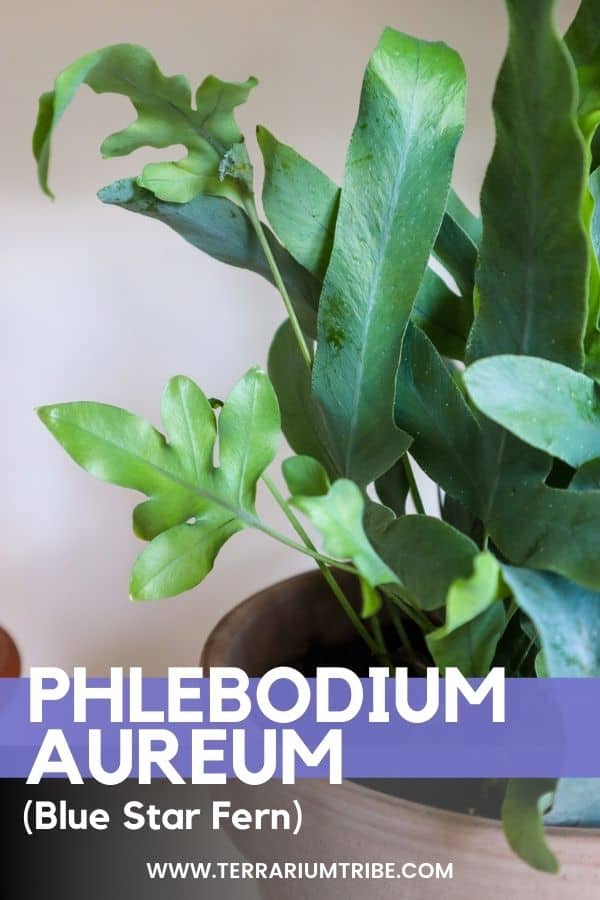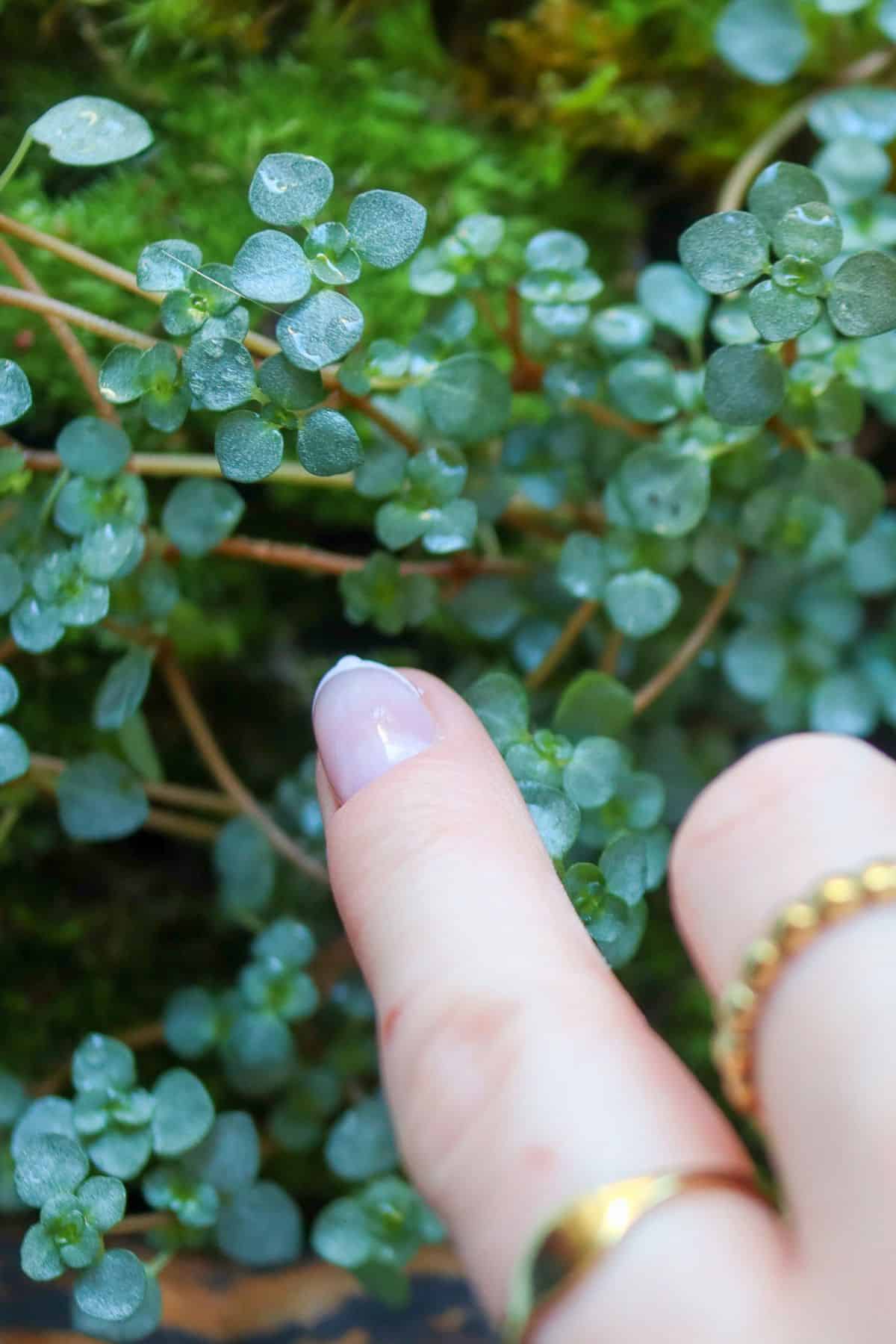Phlebodium aureum, the Blue Star Fern, is a big, funky fern that commands attention.
Its wild, fanned-out fronds always bring texture to the party. And, of course, with a fabulously bluish hue, it’s clear where it gets its name from.
This fern also (unhelpfully) goes by another common name, the Golden Polypody, which comes from the gold-colored fuzzy rhizomes at the base of the plant.
Whatever you want to call it, this gorgeous tropical fern is very easy to grow in the home and thrives in a closed terrarium environment.
However you use it, it’s sure to bring some dynamic color and foliage, so let’s jump in.

Where to Buy the Blue Star Fern
See the links below to purchase from reputable terrarium plant shops and marketplaces (may include affiliate links).
Blue Star Fern Care & Growth
| Plant Type | Fern, epiphyte |
| Lighting | Bright indirect light |
| Temperature | 50-80°F (10-26°C) |
| Watering | Moderate, even moisture |
| Humidity | Medium to high humidity (55-80%) |
| Growth | 3 inches to 6 feet |
Lighting Requirements
Being an epiphytic plant, Phlebodium aureum grows on top of trees in its native environment. Naturally, it’s evolved to flourish in the shade of the canopy with dappled light.
So, in a terrarium or home environment, this fern likes gold-standard bright but indirect light.
The color of the fronds can vary depending upon how much light it receives, from bright green/blue-toned to more washed out and pale in lower light conditions.

Though their fronds are thicker than most other fern leaves, they still don’t like direct sun for long periods of time.

Watering
Phlebodium aureum (as with most ferns) loves its water and likes to maintain a moderate to high level of moisture.
I like to keep mine regularly topped up with water. As long as you have a pot with a drainage hole, you can water it fairly freely.
Epiphytes are especially sensitive to being sat in soggy soil, so good drainage is essential.
In a terrarium build, you can’t be so free and easy with the watering. It’s very easy to add too much, so start small with a few sprays and add a little more over the coming days and weeks if needed.

Best Soil/Substrate
Because it’s an epiphyte, the Blue Star Fern prefers loose, well-draining soil – something that holds moisture but, more importantly, has excellent aeration.
Growing attached to a tree, the roots of this fern would be free and easy, so when planted terrestrially, it’s important to try to recreate those conditions.

Of course, in the wild, it wouldn’t be growing in nutrient-dense soil, so be careful not to over-fertilize this plant.
Adding some worm castings into the substrate is a great way to make sure you don’t overdo it.
Temperature & Humidity Needs
Originating from the rainforests of South America, you won’t find it surprising to hear that Phlebodium aureum enjoys its fair share of warmth and high humidity.
And as with most tropical ferns, maintaining a higher humidity level is key.
You’ll need to keep your home consistently over 50%.
I don’t find this particularly hard in the UK, but depending on where you live, you might find it a little tricky.
A great way to boost humidity is to keep watering cans around the room to evaporate or try grouping plants (my favorite excuse to buy more).

And it’s far more forgiving on the temperature front. While I’d aim to keep it above 60°F (for your sake, as much as the plant), it can tolerate as low as 50°F at times.
Growth Pattern
The Blue Star Fern is an absolutely gigantic species in the wild, showcasing mature fronds extending up to 50 inches long (127 centimeters).
They are so long and heavily forked that they almost look like mature Monstera fenestrations.

While these plants can get fairly large in the home, they certainly won’t grow anywhere near that big and are somewhat limited by the space they have to grow.
Because they grow from a rhizome, I’ve found they grow bushier rather than longer.
In a terrarium, this fern can make itself the star of the show and outgrow the space, so keep an eye on it and trim or swap it out for a smaller plant where necessary.

How to Propagate
In the wild, Phlebodium aureum ferns release spores to continue their family line.
You might see a few pop up on yours, but under the watchful human eye indoors, it’s far easier to propagate this plant via division.

To divide your plant. Get your thumbs in the soil/root ball and start to tease it into two or more sections.
Once you have the roots separated, grab a pair of scissors or secateurs and snip through the rhizome so that each section has a decent amount of roots, rhizome, and fronds.

Depending upon the age of the plant, the parent can be split to produce many babies at a time.
Phlebodium Varieties & Similar Plants
The Phlebodium genus is relatively small, with only one other notable player, Phlebodium davana.
It’s similar to the aureum but with much frillier, lettuce-like leaves.
If you’re looking for similar plants, I’d argue some members of the Microsorum genus share a lot of resemblance with their board, often forked fronds.
Check out Microsorum diversifolium or Microsorum musifolium for other terrarium-ready fern species.
Or, if you want to stick to the blue theme, why not check out Selaginella uncinata (Peacock Plant) or Pilea glauca ‘Aquamarine’?

